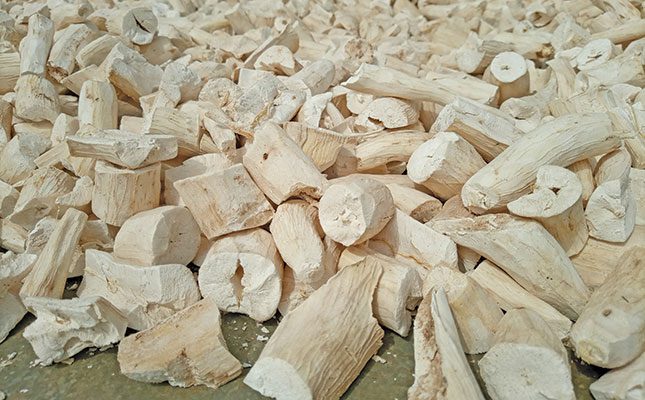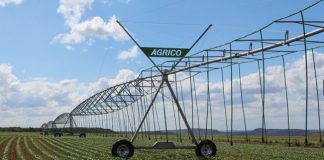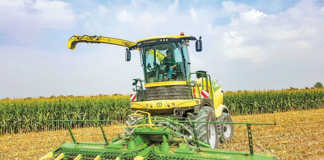
Photo: Wikimedia Commons
Cassava (Manihot esculenta), also known in some African countries as tapioca, mandioca, yuca or umdumbulu, was domesticated mainly on the south-western rim of the Amazon in South America.
In the 16th century, when trade between Brazil and Africa began, Portuguese traders brought the crop to the Congo Basin. Two centuries later, it was introduced independently to East Africa and Madagascar.
Cassava is a root tuber similar to the sweet potato. It is drought-tolerant, grows in poor soil conditions, and requires little to no fertiliser.
Cassava has been transformed from a ‘poor man’s crop’ into a lucrative industrial crop, and is now processed into products such as starch, flour and glucose.
For processors, its key attributes are that it contains 70% starch by dry weight and is high in carbohydrates, making it an excellent crop for ethanol for industrial use and feeds for livestock. It is also used in medicine, adhesives and the paper industry.
Smallholder farmers in Africa cultivate and prepare cassava using conventional techniques such as planting cuttings vertically, planting freshly cut cuttings, and using intercropping during the crop’s early growth stages with maize, beans and spinach.
The crop is grown and sold largely by resource-constrained farmers in their communities, where it provides much-needed income and employment.
Nigeria is the world’s largest cassava producer. While African countries are reported to have contributed 61% of global cassava production in 2018, South Africa is a major importer of cassava starch.
Cassava in South Africa
Despite the socio-economic importance of cassava, its agricultural potential in South Africa has not been exploited, as the crop is produced on a small scale and traded informally, resulting in a limited supply on the formal market. This is due to a lack of established marketing channels, weak infrastructure and market information, and an underdeveloped value chain.
In Mpumalanga, for example, a commercial cassava starch processing plant was closed due to an insufficient supply of raw cassava. Most of the cassava starch used by the South African meat-processing industry is imported from Thailand. The import value of cassava starch in 2021 is estimated at over R100 million.
The Agricultural Research Council, in partnership with the National Agricultural Marketing Council, is conducting a study on cassava production in South Africa.
Thus far, we have discovered that most cassava in the country is produced by small-scale farmers in KwaZulu-Natal, Mpumalanga and Limpopo for home consumption. Elderly (up to 89-year-old) cassava farmers interviewed in KwaZulu-Natal recall that cassava was a staple crop during their childhood, implying that the crop has been grown for at least 90 years in South Africa.
Despite being an important crop for these and similar communities, cassava has received little attention from academic and public institution researchers, and its popularity is low. As a result, cassava is only accessible in the formal market to those living outside of South Africa.
Cassava-producing farmers in South Africa indicated that they were willing to expand their scale of production. However, their options are limited due to a lack of processing companies and market expertise. Given that cassava spoils 24 hours after harvest due to enzymatic postharvest physiological deterioration, large-scale production of the crop without a well-established market is obviously a risk.
In light of this, farmers need to receive training to help them produce high-quality cassava, while special attention needs to be given to marketing and distribution of the product.
Agricultural policies, too, should be revised to encourage production and marketing, mindful of the fact that cassava is a poverty-relieving and climate-smart crop.
Indeed, it is difficult to understand why production of the crop in South Africa is so limited, while it is so important to alleviating poverty elsewhere in Africa. In addition, South Africa is a major importer of cassava starch, indicating considerable potential for local production.
Cassava is a competitive commercial agricultural product with benefits for farmers, processors, marketers and consumers. Logically, a developed cassava starch industry in South Africa has the potential to unlock employment, improve rural livelihoods, and enhance agricultural production and agro-processing.
Strategic partnerships needed
Strategic partnerships between the private and public sector are recommended to develop
the cassava value chain. The National Development Plan 2030 calls for more development in rural areas to enhance economic participation and more support for farmers to increase their agricultural output.
The value chain should therefore involve smallholder farmers by distributing better-quality planting material, implementing intensive cassava production, and establishing community-based primary processing systems.
Developing a cassava industry is in line with South Africa’s Bio-economy Strategy, launched in 2013, which aims to explore multi-purpose, climate-resilient, adaptable crops with the potential to contribute towards multiple national priorities.
Email Light Ngobeni at [email protected], or Zinhle Nkosi at [email protected].










